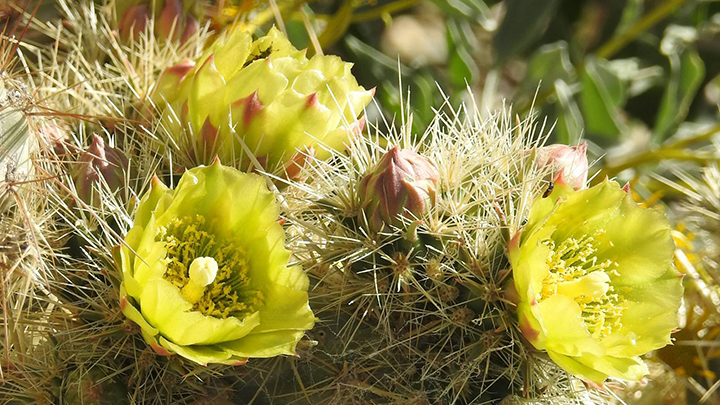Q&A: Superbloom 2024
SDSU biologists Lluvia Flores-Renteria and Mike Simpson explain the science behind the explosion of flowers following the winter’s heavy rains.

This winter’s unusually heavy rainfall is bringing an abundance of flowers to Southern California, especially its desert regions.
NewsCenter’s Susanne Clara Bard asked biologists Lluvia Flores-Renteria and Mike Simpson to explain the biology behind the superbloom and what to look for in this year’s flower extravaganza.
How has winter rainfall affected wildflower blooming this spring in California and Baja California?
This past winter was marked by the presence of the meteorological phenomenon known as El Niño which usually brings cold, wet winters to California and the Southern U.S. The unusually high precipitation levels have resulted in a spring superbloom in Southern California. The lower temperature conditions experienced this year have delayed the blooming of the plants in some areas compared to hotter years. A superbloom is expected in San Diego County and surrounding areas in the next few weeks as temperatures rise.
What causes superblooms from a biological perspective?
Wildflowers are annual plants that produce a lot of seeds that accumulate in the soil in what we call the seed bank. The seeds can remain dormant for years, waiting for the right conditions to germinate and bloom in unison. With high winter precipitation, seed dormancy is “released,” and a high density of plants emerge and are able to establish and mature. If conditions remain favorable they produce flowers and seed-producing fruits throughout the spring. Plants require a mixture of conditions to bloom. For example, warmer temperatures and longer days compared to the shorter and colder days of winter. The superbloom is a gradual process, with plants at lower elevations blooming earlier than plants at higher elevations. That is because the temperature decreases approximately one degree Celsius for every 100 meters in elevation.

Brittlebush (Encelia farinosa) blooming in Anza Borrego State Park (Susanne Clara Bard)
Are there any downsides to large amounts of rainfall from the plants' perspective?
In the past year we have witnessed extreme conditions in our region. Extreme rainfall may cause flooding in some areas, resulting in some seeds being washed down to lower areas. As plants are unable to move to escape these challenges, they have evolved a set of traits that allow them to cope. Species with higher genetic diversity might be able to cope with a wider range of environmental pressures. However, some plants might be more susceptible to these extreme climatic conditions. In such cases, strong selection might operate and their populations might decline.
Which types of plants bloom at different times?
Annual wildflowers generally bloom earlier than shrubs, although even these are often spaced out during the peak season depending on species. One exception is ocotillo, a tall shrub that will bloom soon after a period of precipitation. Cacti generally bloom a bit later than annuals, and some shrubs may bloom into the early summer.
How does rainfall affect different plant species?
Our region belongs to the biodiversity hotspot known as the California Floristic Province, which is largely dominated by woody perennial shrubs. Across California, species richness is positively correlated with rainfall. However, increased rainfall has also facilitated the invasion of annual exotic plants. These invasive plants can germinate earlier, and also grow faster during high rainfalls. They can often out-compete native plant species. On the other hand, these opportunistic exotic plants might be more negatively impacted by drought compared with native species.
 Chuparosa (Justicia californica) flowering in Anza Borrego State Park. (Susanne Clara Bard)What are some good places people might be able to see wildflowers this spring?
Chuparosa (Justicia californica) flowering in Anza Borrego State Park. (Susanne Clara Bard)What are some good places people might be able to see wildflowers this spring?
Traditionally, the areas around Borrego Springs are sites where people flock during a superbloom. Popular sites are the areas along Henderson Canyon Road north of Borrego Springs and the Borrego Palm Canyon trail in Anza Borrego Desert State Park. These and other areas in the park will likely be visited heavily this spring by wildflower enthusiasts.
Any recommendations for how to best observe the spring bloom without damaging the environment?
Wildflowers are fragile and we can kill the plants by trampling on them. We always recommend that people observing wildflowers walk around the plants or on designated trails; the popular habit of lying in the plants for a photograph will damage the plants beneath and should be avoided. Also avoid bringing dogs to the wildflower areas, or, if necessary, keep them on a leash.
 Wildflowers blooming in Anza Borrego State Park. (Susanne Clara Bard)
Wildflowers blooming in Anza Borrego State Park. (Susanne Clara Bard)



